Passengers 237 Fatalities 228 Survivors 26 | Crew 17 Injuries (non-fatal) 25 Date 6 August 1997 Number of deaths 228 Survivor 26 | |
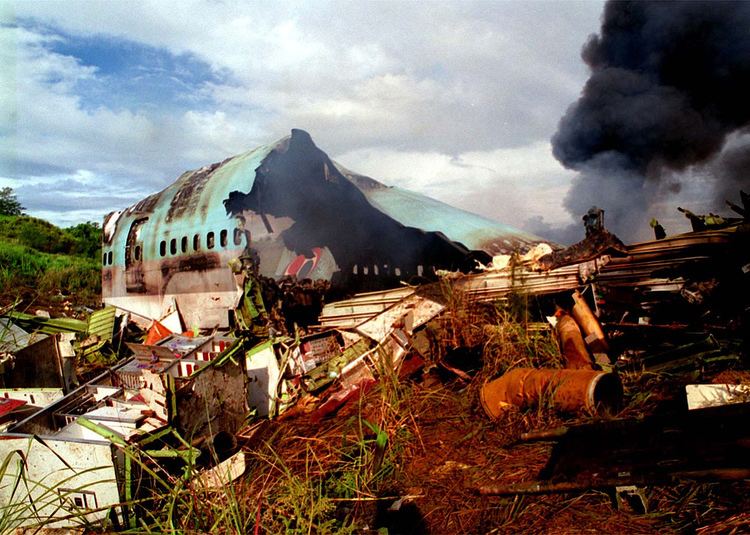 | ||
Similar Korean Air Cargo Flight 8509, Korean Air Lines Flight 007, American Airlines Flight 1420, Air France Flight 358, American Airlines Flight 965 | ||
accident of korean air flight 801 kal801 detailed crash simulation of ntsb
Korean Air Flight 801 (KE801, KAL801) crashed on August 6, 1997, on approach to Antonio B. Won Pat International Airport, in the United States territory of Guam, killing 228 of the 254 people aboard.
Contents
- accident of korean air flight 801 kal801 detailed crash simulation of ntsb
- Disaster
- Rika Matsuda
- Investigation and probable cause
- Passengers
- Deaths and injuries
- Notable passengers
- Identification and repatriation of bodies
- After the crash
- Legacy
- In popular culture
- References
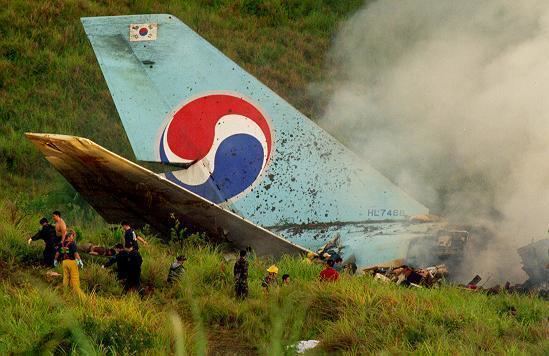
Flight 801 was normally flown by an Airbus A300; since Korean Air had scheduled the August 5–6 flight to transport Guamanian athletes to the South Pacific Mini Games in American Samoa, the airline designated HL7468, a 12-year-old Boeing 747-300 delivered to Korean Air on December 12, 1984, to fly the route that night. The aircraft crashed on Nimitz Hill in Asan, Guam, while on approach to the airport.
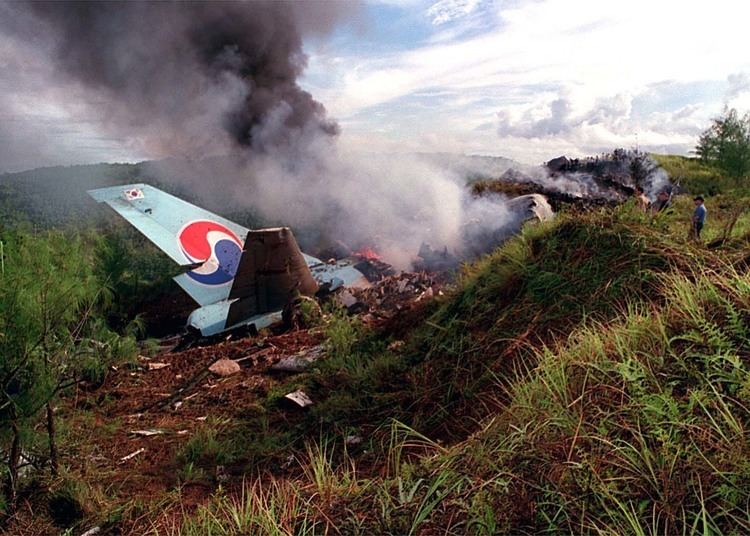
Disaster
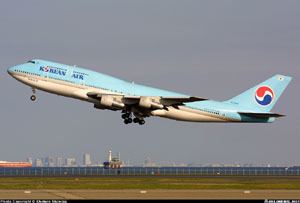
Flight 801 departed from Seoul-Kimpo International Airport (now Gimpo Airport) at 8:53 p.m. (9:53 p.m. Guam time) on August 5 on its way to Guam. It carried two pilots, a flight engineer, 14 flight attendants, and 237 passengers, a total of 254 people. Of the passengers, three were children between the ages of 2 and 12 and three were 24 months old or younger. Six of the passengers were Korean Air flight attendants who were deadheading.
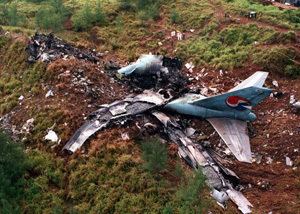
The flight was under the command of 42-year-old Captain Park Yong-chul (Korean: 박용철, Hanja: 朴鏞喆, RR: Bak Yong-cheol. M-R: Pak Yongch'ŏl) The captain had close to 9,000 hours of flight time and had recently received a Flight Safety Award for negotiating a 747 engine failure at low altitude. Park had originally been scheduled to fly to Dubai, United Arab Emirates; since he did not have enough rest for the Dubai trip, he was reassigned to Flight 801. The first officer was 40-year-old Song Kyung-ho (Korean: 송경호, RR: Song Gyeong-ho, M-R: Song Kyŏngho), who had more than 4,000 hours' flying experience, and the flight engineer was 57-year-old Nam Suk-hoon (Korean: 남석훈, RR: Nam Seok-hun, M-R: Nam Sŏkhun), a veteran pilot with more than 13,000 flight hours.
The flight experienced some turbulence but was uneventful until shortly after 1:00 a.m. on August 6, as the jet was preparing to land. There was heavy rain at Guam so visibility was significantly reduced and the crew attempted an instrument landing. The glideslope Instrument Landing System (ILS) in runway 6L was out of service; however, the captain believed it was in service and at 1:35 am managed to pick up a signal which was later identified to be from an irrelevant electronics device on the ground. The crew noticed that the aircraft was descending very steeply, and noted several times that the airport "is not in sight." Despite protests from the flight engineer that the detected signal was not the glide-slope indicator, the captain pressed on and at 1:42 am, the aircraft flew into Nimitz Hill, about 3 nautical miles (5.6 km) short of the runway, at an altitude of 660 feet (200 m).
Of the 254 people on board, 228 died as a result of the crash. One survivor, 36-year-old Hyun Seong Hong (홍현성, also spelled Hong Hyun Sung) of the United States, occupied Seat 3B in first class, and said that the crash occurred so quickly that the passengers "had no time to scream" and likened the crash to "a scene from a film."
The rescue effort was hampered by the weather, terrain, and other problems. Emergency vehicles could not approach due to a fuel pipeline destroyed by the crash and blocking the narrow road. United States Navy Seabees of NMCB133 were some of the first on the scene as they utilized their earth moving equipment to clear roadways and timber from the crash site approach. The Seabees used backhoes to crack open the still-burning plane to rescue survivors and erected mortuary tents for first responders. There was confusion over the administration of the effort; the crash occurred on land owned by the United States Navy but civil authorities initially claimed authority. The hull had disintegrated, and jet fuel in the wing tanks had sparked a fire which was still burning eight hours after impact.
Rika Matsuda
Governor Carl T.C. Gutierrez found 11-year-old Rika Matsuda, a South Korean citizen from Japan who boarded the flight with her mother, 44-year-old Cho Sung-yeo (also known as Shigeko). Rika Matsuda described what happened to her and her mother to interpreters. Cho could not free herself from the aircraft and told Rika to run away. Luggage piled on the girl and her mother as the crash occurred; Rika Matsuda said her mother, unable to free herself, asked her to leave. Cho died in the fire. After escaping from the aircraft, Rika discovered a surviving flight attendant, Lee Yong Ho (이용호). They stayed together until Gutierrez discovered them. Rika Matsuda, treated at Guam Memorial Hospital in Tamuning, was released on August 7, 1997. The girl and her father, Tatsuo Matsuda, were escorted to the Governor House where they were the guests of Gutierrez and the First Lady of Guam, Geri Gutierrez, for several days; afterwards Rika and Tatsuo Matsuda flew to Japan.
Investigation and probable cause
A special weather observation made at 01:47 three minutes after the impact reported:
Wind variable at 4 knots; visibility—5 miles; present weather—light rain shower; sky condition—few 1,500 feet, scattered 2,500 feet, overcast 4,000 feet; temperature 26° C; dew point 24° C; altimeter 29.85 inches Hg.
The U.S. National Transportation Safety Board (NTSB) investigation report stated that a contributing factor was that the ATC Minimum Safe Altitude Warning (MSAW) system at Antonio B. Won Pat International Airport had been deliberately modified so as to limit spurious alarms and could not detect an approaching aircraft that was below minimum safe altitude. The probable cause of the accident was the captain's poor execution of the non-precision approach, the captain's fatigue, poor communication between the flight crew, and Korean Air's lack of flight crew training. The crew had been using an outdated flight map which was missing a 724 foot obstruction symbol depicted at the NIMITZ VOR and that map stated the Minimum Safe Altitude while crossing the NIMITZ VOR for a landing aircraft was 1,300 feet (400 m) as opposed to the updated altitude of 1,440 feet (440 m). Flight 801 crashed near the NIMITZ VOR which is situated on Nimitz Hill at a height of 680 feet (210 m) at 1:42 am, when it descended below the minimum safe altitude of 1,440 feet (440 m) during its landing approach. The report also identified that the captain may have mistakenly believed that the airplane was closer to the airport than it was and that there may have been confusion about the location of the Distance Measuring Equipment(DME) in relation to the airport, with the crew anticipating the VOR/DME to be located at the airport. The DME was sited at the NIMITZ VOR some 3.3 nm from the airport and such a configuration had not been part of Korean Air's simulator training, the crew's training for such non-precision approaches having been carried out in scenarios where the DME was located at the airport. Nevertheless the correct DME distances were shown on the approach chart.
The NTSB presented its findings on March 24, 25, and 26, 1998 in the Hawaii Convention Center in Honolulu.
The section of the report entitled "Probable Cause" concluded:
The National Transportation Safety Board determines that the probable cause of this accident was the captain’s failure to adequately brief and execute the non-precision approach and the first officer’s and flight engineer’s failure to effectively monitor and cross-check the captain’s execution of the approach. Contributing to these failures were the captain’s fatigue and Korean Air’s inadequate flight crew training. Contributing to the accident was the Federal Aviation Administration’s intentional inhibition of the minimum safe altitude warning system at Guam and the agency’s failure to adequately manage the system.
Passengers
Many of the passengers were vacationers and honeymooners flying to Guam.
11-year old Rika Matsuda, a South Korean passport holder, was described as Japanese in many press reports. One South Korean was an expatriate who lived in Guam, while New Zealander Barry Small worked in Guam.
Deaths and injuries
Of the 254 people on board, 223 - 209 passengers and 14 crew members (3 flight crew and 11 cabin crew) - were killed at the crash site.
Of the 31 occupants found alive by rescue crews, two died en route to the hospital and a further three in hospital. Among the survivors, 16 received burn injuries. The 26 survivors were initially treated at Guam Memorial Hospital (GMH) in Tamuning or at the U.S. Naval Hospital in Agana Heights. Four were subsequently transferred to the U.S. Army Burn Center in San Antonio, Texas. and eight to University Hospital in Seoul.
There were 23 passengers and three flight attendants who survived the crash with serious injuries.
Notable passengers
Shin Ki-ha, a four-term South Korean parliamentarian and former leader of the National Congress for New Politics, traveled with his wife and around 20 party members. Shin and his wife were killed.
Identification and repatriation of bodies
On August 13, 1997, 12 sets of remains were brought to Guam's airport to be readied to be flown back to Seoul. Clifford Guzman, a governor's aide, said that two of the 12 were taken back to the morgue. Of the 10, one was misidentified and had to be switched before takeoff. The 10 bodies transported to Seoul were of seven passengers and three female flight attendants. On the same date, an NTSB family affairs official named Matthew Furman said that in total, by that date, 46 bodies had been identified.
After the crash
After the crash occurred, the airline provided several flights for around 300 relatives so that they could go to the crash site.
On August 13, 1997, 50 protesters staged at a sit-in at Guam Airport, saying that the recovery of the dead was taking too long; they sat on blankets and sheets of paper at the Korean Air counter.
Legacy
On August 5, 1998, the first anniversary of the crash, a black marble obelisk was unveiled on the crash site as a memorial to the victims.
After the accident, Korean Air services to Guam were suspended for more than four years, leading to reduced tourist spending in Guam and reduced revenues for Korean Air. When Seoul-Guam services resumed in December 2001, the flight number was changed to 805. The flight number for its Seoul-Guam route is now 111 and operates out of Incheon instead of Gimpo, using a Boeing 777-300 or an Airbus A330.
In 2000, a lawsuit was settled in the amount of $70,000,000 United States dollars on behalf of 54 families against the airline.
New Zealander Barry Small, a helicopter pilot and a survivor of the accident, lobbied for safer storage of duty-free alcohol and redesigns of crossbars on airline seats; he said that the storage of duty-free alcohol on Flight 801 contributed to spreading of the fire and the crossbars injured passengers to the point where they could not escape from the aircraft.
The Government of Guam moved its website about the Korean Air crash after the Spamcop program alerted the government that advance fee fraud spam from Nigeria used the website link as a part of the scam. Scam e-mails used names of passengers, such as Sean Burke, as part of the fraud.
Following the Korean Air 801 crash, it was brought to the NTSB's attention that foreign carriers flying in and out of the US were not covered by the Aviation Disaster Family Assistance Act of 1996 and Korean Air did not have a plan to deal with the situation they encountered. As a result, US Congress passed the Foreign Air Carrier Family Support Act of 1997 to require those carriers to file family assistance plans and fulfill the same family support requirements as domestic airlines. Not only does the Act ensure that all victims and family members will be treated equitably, regardless of the carrier they use, it also impels many carriers that may not have thought about family assistance issues to give them due consideration in their emergency response plans.
